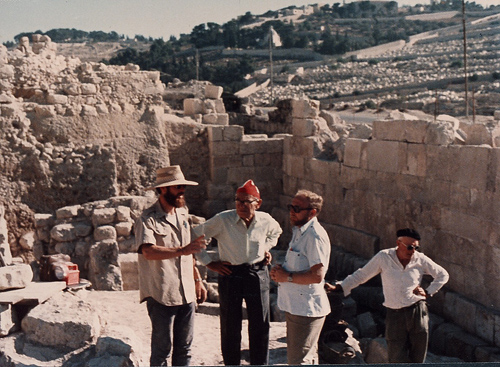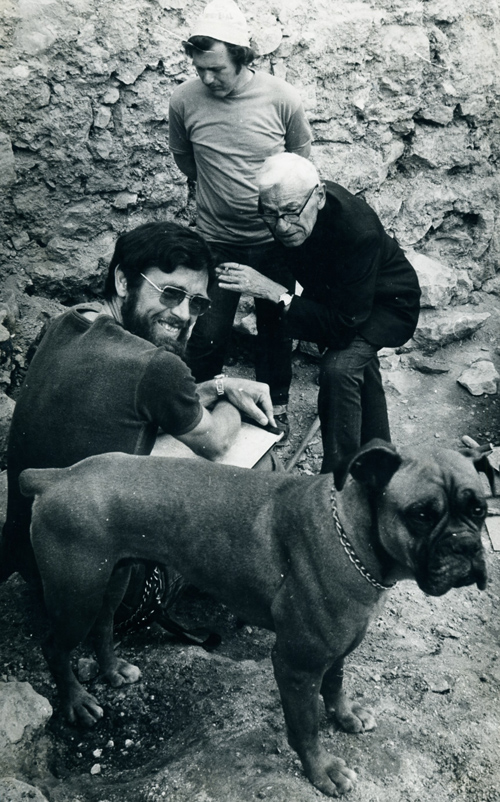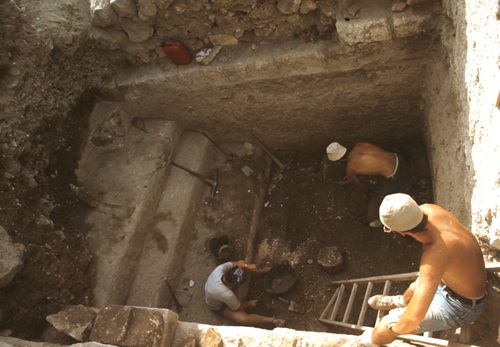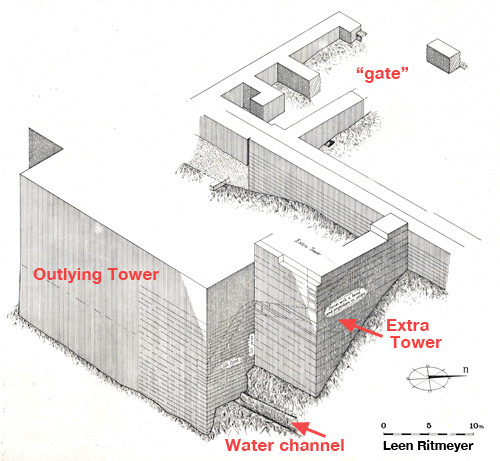The inauguration of a complex dating from the First and Second Temple periods on the Ophel has been widely reported, see for example here and here. In a previous post we mentioned that “The site was first excavated in the 1970′s under the direction of the late Prof. Benjamin Mazar and in the 1980′s and onward, Eilat Mazar has further excavated the site. The site has remains from the Israelite, Herodian (dismantled), Roman, Byzantine and Ummayad periods.”
The site is well known to me as I supervised the excavations of a large Herodian mansion in this area in 1975. My wife Kathleen also excavated in the same area. Moshe Feuer took over the supervision later on. Below the Herodian mansion, he discovered a substantial Iron Age structure that was tentatively identified by Prof. Benjamin Mazar as “The House of Millo”, mentioned in 2 Kings 12.20.

Reporting on the inauguration, Todd Bolen asked the following question:
“I’d be curious to know if there are any other archaeologists who agree with Mazar’s identification of the structure she excavated as a gate. Some years ago it seemed that even those most sympathetic to her views did not follow her on this, but perhaps that has changed. I note that the press release does not state that this is a gate but that “Mazar suggests” that it is a gate.”
I will try to answer this question. While studying Warren’s plans of this area, it became clear to me that the excavated remains were connected with a large tower-like structure, dubbed by him “The Tower that lieth out” (Nehemiah 3.26). I tried to excavate this area which is located on the other side of the road, but was stopped by the religious authorities who claimed that a Medieval Jewish cemetery was located there, which subsequently proved to be correct.
Some 10 years later, under the direction of Prof. Benjamin Mazar and his granddaughter Eilat, the excavations were expanded to the east where a large structure of the First Temple period was found. When Eilat investigated the previously excavated area, she asked me to make the plans.
While working on the plans, I imposed symmetry on the remains and at that moment I thought that the structure excavated by Moshe Feuer could have been a gateway.

Working with Professor Benjamin Mazar was always a great pleasure as he often bounced off ideas during the many “brainstorming” sessions we had. I showed my preliminary ideas about the gate to Eilat, indicating the location where to excavate in order to prove that it was a gate. Instead of investigating the possibility, she invited the media the next day to announce that she had discovered the Water Gate! See Jerusalem Post report of April 22, 1986.
The Jerusalem Post reports that “Mazar believes the area is described in the Torah in the verse about King Solomon’s Temple: “… and the temple servants living on Ophel repaired to a point opposite the Water Gate on the east and the projecting tower” (Nehemiah 3:26). It may have been called the Water Gate because of the plethora of mikvaot in the area.”
This is a very uninformed statement, as Nehemiah 3 does not mention any temple, let alone Solomon’s Temple and the Book of Nehemiah is not part of the Torah (the five Books of Moses). The connection between the “Water Gate” and the mikvaot is untenable as the “gate” belongs to the First Temple period and the mikvaot to the Second Temple period. The earliest mikvaot date to the first century BC.

I no longer believe that the building in question is a gate, as the chambers do not resemble those of Iron Age gateways. The only complete chamber was stacked full with large storage jars which is also untypical of gateways. It would appear now that the building was a storage facility connected to a large domestic or public building.
Reading Nehemiah 3.26, it is clear that the “Water Gate” and “the tower that lieth out” are separate points along the wall. The Water Gate must therefore be located south of the tower (somewhere near the Gihon Spring). According to Warren’s excavations, this outlying tower consists of two elements, a large tower and a smaller L-shaped wall (called by Warren the “Extra Tower”). The latter was built apparently to strengthen the larger tower.

As there are some structures in this area, which, according to Eilat, belong to the 10th century BC. and if the outlying tower, which has not been excavated, belongs to this period, then the L-shaped “Extra Tower” structure must be later.
As a water channel from the First Temple period Bethesda Pool enters the “outlying tower” from the northeast, I would suggest that the “Water Gate” building served as a water distribution point, possibly during the time of King Hezekiah after he conducted the water of the Gihon Spring to the Siloam Pool. This would have left the Ophel area without a water supply and therefore a new water distribution point (where the storage jars could have been used) may have been created here to meet the needs of the local population.

Leen,
Are you saying that you think the Water Gate is nowhere near the site being excavated by Mazar but rather much further up the eastern side of the city near the Gihon Spring? Would you then associate it with the “Spring House” uncovered by Reich/Shukron?
Also I am not clear how you see the Bethesda Pool as associated with the Gihon Spring. (Unless I am simply reading you incorrectly.)
Any information would be helpful.
Cam
Cam,
I believe that the Water Gate was located in the eastern city wall, but further to the south of the area in question.This gate has not been found yet, but it should be closer to the Gihon Spring. The Spring Tower was no longer in existence at the time of Nehemiah.
The Bethesda Pool was already in existence during the First Temple period (see for example Dan Bahat: Illustrated Atlas of Jerusalem, p.28). This water reservoir was then known as the Sheep’s Pool. An aqueduct ran south of this pool, along the Eastern Wall of the Temple Mount to the Outlying Tower. This aqueduct may possibly have continued further south to Area G.
so there is no basis for this drawing?
http://www.jpost.com/HttpHandlers/ShowImage.ashx?ID=168145
oh if they would explain themselves as you do for your conclusions with your drawings and pictures from the whole arwea, then i would understand their theory.
Leen, I find it so gratifying to see how our old dig site continues to serve as a focal point in Jerusalem’s history. Thank you for displaying the Mikveh photo showing Harry, Jim and I hard at work! Ironically, it is only the second photo I now have showing me working at the dig. As to the Ophel connection, I still remember the day I was working alone digging down to the bedrock at the great cistern entrance under the Herodian building and Prof Mazar came down and we discussed the Iron Age sherds I was finding under the Herodian floor. Even then in 1975 he believed this area was the location of the Millo.
Hi Stephen,
Glad you liked the photograph. They were great times.
They were. To be Indiana Jones before him…that’s what we all were. Leen. I can never thank you enough for providing me the opportunity to stay and “play” digging in the earth…such precious earth. When I returned in ’77 with my wife and saw the site how my heart ached to be back. To be honest, I have never been happier then when I was uncovering Jerusalem’s bones! Ah, to be that young 165 pound man again. Indeed those were the days!
Leen,
Just a quick question. At the time of rebuilding the walls of Jerusalem, I am even wondering if Water Gate was ever rebuilt because I re-read Nehemiah 3:26 several times and do not see any mention of it being rebuilt. All I could read was this gate was the opposite of another point, I guess, the projecting tower. I then read Nehemiah 8:1; 3 “the square before the Water Gate” Would that mean the Water Gate was rebuilt or was not needed to be rebuilt? I recognize that would be hard to tell, right?
Brent,
It is indeed difficult to tell. Neh. 3.26 informs us that the city wall of the outlying tower was rebuilt, but not necessarily anything else. That could have been done later on, of course, as Neh. 3 relates the building of the city wall only as a first priority. The square of Neh. 8.1,3 could have been used even if the “Water Gate” wasn’t rebuilt yet.